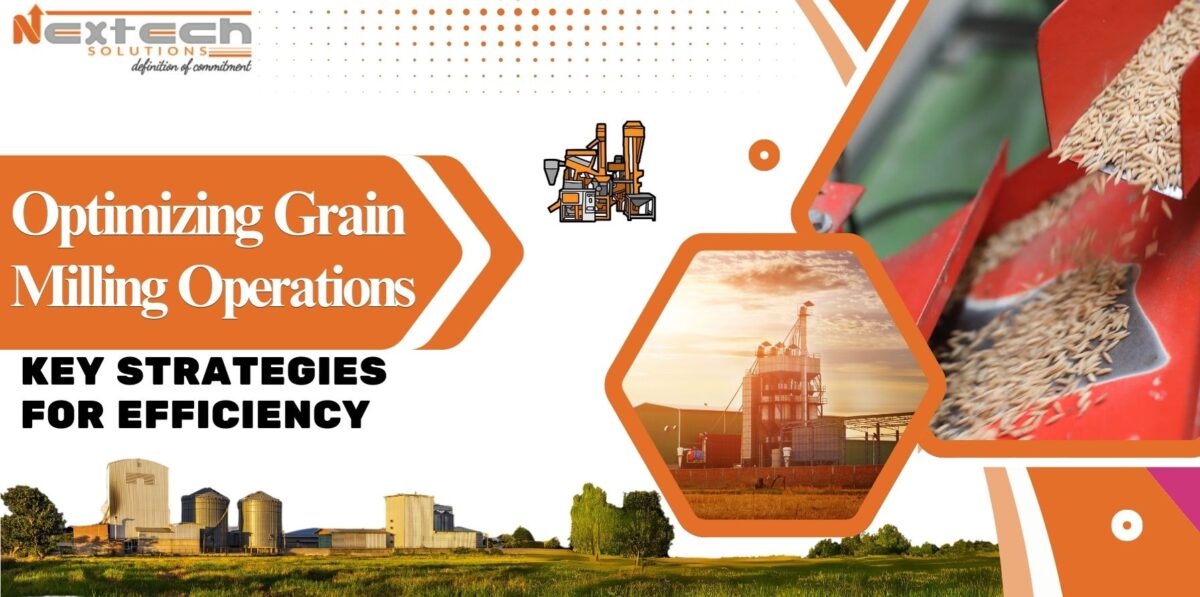Grain milling is a critical process in the agricultural and food production industries, transforming raw grains into various products such as flour, meal, and grits. Achieving efficiency in grain milling operations is essential for maximizing productivity, reducing waste, and ensuring the quality of the final product. Nextech Agri Solutions, a leading provider of grain milling solutions, offers comprehensive strategies to enhance milling efficiency. This blog explores key strategies for optimizing grain milling operations.
Understanding Grain Milling
Grain milling involves several stages, including cleaning, conditioning, grinding, and sifting. Each stage plays a crucial role in ensuring the final product’s quality and consistency. Understanding the intricacies of these processes is the first step toward optimization.
-
Cleaning and Conditioning
Cleaning: The initial stage of grain milling involves removing impurities such as stones, dust, and other foreign materials from the raw grains. Effective cleaning ensures that the grains are free from contaminants that could affect the quality and safety of the final product.
Conditioning: After cleaning, the grains undergo conditioning, which involves adding moisture to achieve the desired moisture content. Proper conditioning softens the grain, making it easier to grind and improving the efficiency of the milling process.
2. Grinding and Sifting
Grinding: This stage involves breaking down the conditioned grains into smaller particles using various types of mills, such as hammer mills, roller mills, and impact mills. The choice of mill depends on the type of grain and the desired end product.
Sifting: After grinding, the milled product is sifted to separate the different particle sizes. Sifting ensures that the final product meets specific quality standards and is suitable for its intended use.
Key Strategies for Optimizing Grain Milling Operations
1. Implementing Advanced Milling Technologies
Modern grain milling technologies offer significant advantages over traditional methods, including improved efficiency, precision, and consistency. Investing in advanced milling equipment can lead to better control over the milling process, reduced energy consumption, and higher yield.
2. Automation and Control Systems
Automation plays a vital role in optimizing grain milling operations. Automated control systems can monitor and adjust various parameters, such as temperature, moisture content, and grinding speed, in real-time. This ensures optimal performance and reduces the risk of human error.
3. Enhancing Grain Quality
The quality of the raw grain directly impacts the efficiency and effectiveness of the milling process. Implementing quality control measures at every stage of grain handling, from harvesting to storage, can significantly improve milling outcomes.
4. Proper Storage Practices
Maintaining optimal storage conditions for raw grains is essential for preserving their quality. Grain should be stored in a clean, dry environment with controlled temperature and humidity levels to prevent spoilage and contamination.
5. Regular Maintenance of Milling Equipment
Regular maintenance of milling equipment is crucial for ensuring smooth operation and minimizing downtime. Scheduled inspections, cleaning, and repairs can help identify and address potential issues before they escalate, prolonging the lifespan of the equipment and maintaining optimal performance.
6. Predictive Maintenance
Predictive maintenance involves using data and analytics to predict when equipment is likely to fail or require servicing. This proactive approach can help prevent unexpected breakdowns and reduce maintenance costs by addressing issues before they become critical.
7. Energy Efficiency
Energy consumption is a significant cost factor in grain milling operations. Implementing energy-efficient practices can lead to substantial cost savings and reduce the environmental impact of the milling process.
8. Optimizing Equipment Operation
Optimizing the operation of milling equipment can significantly reduce energy consumption. This includes adjusting operating parameters, such as grinding speed and pressure, to achieve the desired output with minimal energy use.
9. Energy Recovery Systems
Energy recovery systems can capture and reuse waste energy generated during the milling process. For example, heat generated by mills can be used for grain conditioning or other processes, improving overall energy efficiency.
Leveraging Data and Analytics
Data and analytics play a crucial role in optimizing grain milling operations. By collecting and analyzing data on various aspects of the milling process, operators can gain valuable insights into performance, identify areas for improvement, and make informed decisions.
1. Process Optimization
Data-driven process optimization involves using analytics to identify inefficiencies and implement targeted improvements. This can include adjusting milling parameters, optimizing equipment settings, and refining cleaning and conditioning processes.
2. Performance Monitoring
Continuous performance monitoring allows operators to track key metrics, such as yield, energy consumption, and product quality, in real-time. This enables prompt identification of issues and ensures that the milling process remains within optimal parameters.
Training and Development
Investing in the training and development of milling personnel is essential for achieving and maintaining high levels of efficiency. Well-trained operators are better equipped to manage the milling process, troubleshoot issues, and implement best practices.
1. Continuous Learning
Encouraging continuous learning and professional development can help milling personnel stay up-to-date with the latest technologies, techniques, and industry trends. This fosters a culture of innovation and continuous improvement within the organization.
2. Collaborative Approach
Promoting collaboration between different departments, such as quality control, maintenance, and operations, can lead to more effective problem-solving and process optimization. A collaborative approach ensures that all aspects of the milling process are aligned and working towards common goals.
Conclusion
Optimizing grain milling operations requires a comprehensive approach that encompasses advanced technologies, quality control, regular maintenance, energy efficiency, data analytics, and personnel training. By implementing these key strategies, businesses can enhance productivity, reduce costs, and ensure the consistent quality of their products. Nextech Agri Solutions is committed to providing cutting-edge grain milling solutions that empower businesses to achieve these goals and excel in a competitive market.
 MAIL US :
MAIL US :
 CALL US :
>
CALL US :
>
